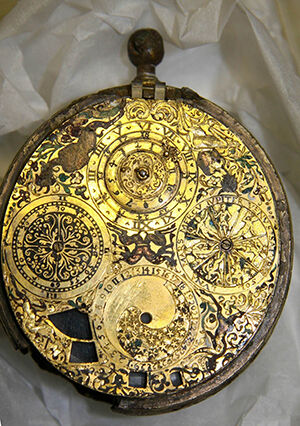University News Last updated 15 November 2013

Elizabethan craftsmen developed advanced manufacturing technology that could match that of the 21st century, a major new exhibition will reveal.
A specialist time team from Birmingham City University have helped to analyse a 400-year-old hoard of jewellery - discovering the 'iPod' of its day among the stunning gems.
The Museum of London has opened a major new exhibition investigating the secrets of the Cheapside Hoard. This extraordinary and priceless treasure of late 16th/early 17th century jewels and gemstones - displayed in its entirety for the first time in over a century - was discovered in 1912, buried in a cellar on Cheapside in the City of London.
Among the historic find is a Ferlite watch that dates back to the 1600's and is so technologically advanced it has been described as the "iPod of its day".
Dr Ann-Marie Carey, a research fellow at Birmingham City University, and her colleagues have used modern technology to discover how these beautiful items were created - and have been stunned at the advanced technologies that have been applied to construct the items.
"Our forensic analysis has revealed the amazing technologies which craftsman of this period were using - and we fear some of these 400-year-old processes may now be lost to us," said Dr Carey.
"It is has been a fascinating investigation. We think of our own time as one of impressive technological advances but we must look at the Elizabethan and Jacobean age as being just as advanced in some ways."
Selected items of the Hoard are set to be revealed to the world at a major exhibition at the Museum of London until April 27 2014.
The Museum of London selected the Birmingham City University team because of its world-recognised expertise in this type of highly specialist research.
The University experts combined their own background in craft with CAD-technology to investigate the Hoard in an attempt to discover what kind of manufacturing methods could have been used to create the jewellery, which includes brooches, pendants and delicate gemstone rings.
Dr Carey said: "When we received photographs of the Hoard we were fascinated with the level of detail in the jewellery.
"We wanted to know how such pieces were made and to understand the story behind them. Until now there had been little research into the craftsmanship involved so we feel we are making a unique contribution to the forthcoming exhibition."
Dr Carey, with the help of senior technologist Keith Adcock, has used 21st century digital technologies to recreate pieces from the Hoard, including a 'Pearl Dropper', an egg-shaped item that originally featured ribbons of pearls.
The Birmingham City University team has created a bronze version of this item which will be used as part of the exhibition, as well as 'augmented reality' displays of the jewellery items.
"This will create tangible items which will be ideal for visually-impaired visitors who will be able handle items directly," added Dr Carey, who is to showcase the University's research findings both at home and abroad.
Image courtesy of Museum of London